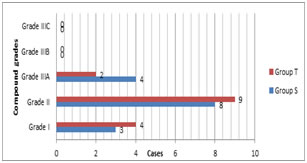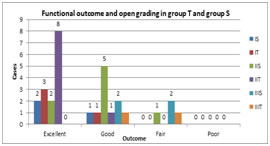Official Journals By StatPerson Publication
|
Table of Content - Volume 9 Issue 1 - January 2019
A randomized control trial of clinical outcome of open fractures of tibia with titanium plates vs stainless steel plate at a tertiary care center
Girish Gadekar1*, Tej Shah2
1Professor, 2Resident, Department of Orthopedics, MGM Medical College, N-6 CIDCO, Aurangabad – 431003 Maharashtra, INDIA. Email: drtejshah@gmail.com
Abstract Background: Open fractures are often associated with high energy injuries. Plating method of fractures stabilization help in early recovery. Titanium plates though costly have shown more safe than stainless steel plates in tibial fractures outcomes. Objectives: This study was aimed to compare clinical outcome between titanium and stainless steel plate reduction in open tibial fractures. Material and Methods: A randomized control trial on 30 cases with tibial fracture was carried out at tertiary care center. 15 cases each were divided into two groups namely group Titanium and group Stainless steel. Cases were followed for 6 months. Data was analyzed using SPPS vs 21. Results: The mean age in Group S and Group T was 36.13 ±12.01 and 35.93 ±15.23 years respectively with no statistically significant difference. (P>0.05). The mean duration of plating and follow up was more in Group S as compared to Group T with no statistically significant difference (P>0.05). But bone union with group T had significantly lesser (P<0.05) duration than group S. There was no any statistical association between any of these variables among two groups intra or post operatively. Group T shows better functional outcome according to grading as compared to Group S with statistically significant difference (P<0.05). Conclusions: titanium plates were found to be more safe and effective than stainless steel. Key Word: Open fractures, Titanium plates, Stainless steel plates, Gustilo classification
INTRODUCTION Fractures of the tibia represent the most common major long-bone fractures that currently confront practicing orthopedic surgeons. The tibia is one of the most commonly fractured long bone with frequency of approximately 11–26 fractures per 100,000 populations per year.1,2The distribution of tibial fracture is bimodal with common incidence of fracture in younger males and older women. 3 The tibia fractures are often open because of the poor anteromedial soft tissue coverage. The fundamental objectives of treatment of open fractures are to manage the soft-tissue injury, minimize the risk of infection, stabilize and repair the skeletal injury and restore the function of the affected extremity. 4 Metal implants were used to provide open fracture reduction to restore anatomical re-alignment and stable internal fixation, allowing early functional rehabilitation. The use of metal in fracture fixation has demonstrated great success owing to its high stiffness, strength, biological toleration and overall reliable function. The most commonly used materials used are pure titanium and electropolished stainless steel, along with newer titanium alloys. Fracture fixation was revolutionized by the introduction of electropolished stainless steel (EPSS) and commercially pure titanium (titanium) in the early- to mid-20th century.5,6 Stainless steel and titanium implants showed to provide a relatively predictable clinical outcome, and offer similar success for fulfilling the main biomechanical and biological requirements of fracture fixation despite distinctive differences in implant properties and biological responses. Hence, the present study was conducted to compare clinical outcome of open fractures of tibia treated with titanium plate versus stainless steel plate.
MATERIAL AND METHODS A randomized open labeled two arm comparative study carried out at conducted at Department of Orthopedics MGM Medical College & Hospital, Aurangabad during the period from 2016 to 2018. A total of sample size of 30 patients with open/compound fractures of tibia (Gustilo classification) was included as per inclusion criteria. Two groups with 15 patients with titanium plates and 15 with stainless steel plates (total 30 patients) selected by simple random sampling. The study was conducted after obtaining clearance from the Ethical Committee of the institute and permission from the appropriate authority. Pre-Structured proforma was used to record personal details. Appropriate laboratory investigation and pre-operative workups were done, patients were operated under general or spinal anesthesia. Patients were routinely followed up in outpatient department at 1 month, 3 months, 6 months. American Orthopedic Foot and Ankle Society Score (AOFAS) was used for final outcome. Data was collected in Microsoft excel and analysis was done by using SPPS vs 21. RESULTS Table 1: Distribution according to age
The above table shows distribution of cases according to age. The mean age in Group S and Group T was 36.13 ±12.01 and 35.93 ±15.23 years respectively with no statistical significant difference. (P>0.05).
Figure 1: Compound grades of fracture (Gustilo-Anderson) The majority of patients in Group S and Group were in Grade II (53.33% and 60%) There was no statistical significant difference seen among both groups with respect to grade of fracture (P>0.05) The majority of patients in Group S and Group were in Grade II (53.33% and 60%) There was no statistical significant difference seen among both groups with respect to grade of fracture (P>0.05)
Table 2: Distribution according to duration of plating, follow up and bone union
The mean duration of plating and follow up was more in Group S as compared to Group T with no statistical significant difference (P>0.05). But bone union with group T had significantly lesser (P<0.05) duration than group S.
Table 3: Intra and post-operatives variables in study groups
There was no any statistical association between any of these variables among two groups intra or post operatively.
Figure 2: Functional outcome according to open grading Group T shows better functional outcome according to grading as compared to Group S with statistical significant difference (P<0.05).
DISCUSSION In the present study, the mean age in Group S and Group T was 36.13 ±12.01 and 35.93 ±15.23 years respectively with no statistical significant difference. (P>0.05) Overall 80% subjects were males and 20% were female, with no statistical significant difference seen among both groups with respect to gender (P>0.05)It was observed that majority of patients had road traffic accident (73.33%) followed by trauma (20%) There was no statistical significant difference seen among both groups with respect to mechanism of injury (P>0.05). Shakir S et al6 studied Titanium versus Stainless-Steel plating in the surgical treatment of distal radius fractures observed no difference in demographics, fracture characteristic between the groups. Holzach P et al7 studied comparison of steel and titanium dynamic compression plates used for internal fixation tibia observed no demographic difference between two groups, which was similar with our study. In the present study the mean duration of plating in Group S was 24.40 ± 1.95 weeks and mean duration of plating in Group T was 22.60 ± 2.94 weeks with no statistical significant difference (P>0.05) Shakir S et al6 also observed no difference in removal rates between the groups which was in accordance with our study.”The comparison of mean duration of follow up among both groups showed that mean duration of follow up in Group S was 6.23 ± 1.22 months and mean duration of follow up in Group T was 5.93 ± 1.28months with no statistical significant difference (P>0.05), similar was concluded by Shakir S et al6 In present study the mean duration of bone union in Group S was 23.26 ± 1.43 weeks and mean duration of bone union in Group T was 21.60 ± 2.47 weeks with statistical significant difference (P<0.05). The mean operative time in Group S was 72.26 ± 6.39 minutes and in Group T was 68.46 ± 4.31minutes with no statistical significant difference (P>0.05). The mean intra-operative bleeding was more in Group S (69.33 ± 6.77 ml) as compared to Group T (65.66 ± 5.30 ml) with no statistical significant difference (P>0.05). Deepak S et al8 reported similar lesser time with titanium as with our study. It was observed that both groups had one intra-operative complication with no statistical significant difference (P>0.05). Time to unassisted mobilization in Group S was 7.13 ± 3.16 days and in Group T was 7.19 ± 3.21 days with no statistical significant difference (P>0.05). Group S had 3 (10%) post-operative complications as compared to Group T (6.67%) with no statistical significant difference (P>0.05). In a study by Soultanis KC et al9 on spinal surgery, when comparing Ti alloy and SS implants, only the SS implants cause late onset postoperative infections. Deepak S et al8 said infection rate was 20% with stainless steel while the success rate for titanium plates was 100%. Holzach P et al7 studied comparison of steel and titanium dynamic compression plates used for internal fixation tibia observed 91% of the titanium group and 93% of the stainless-steel group showed excellent recovery without any loss of movement in the joints. comparison of functional outcome among both groups showed that Group S had 4 (13.33%) excellent functional outcome as compared to Group T (36.67%) Group T shows better functional outcome as compared to Group S with statistical significant difference (P<0.05). Holzach P et al7 studied comparison of steel and titanium dynamic compression plates used for internal fixation tibia observed no difference to be seen between the radiological patterns of fracture healing in the two groups. While Jain R et al10 observed both titanium and stainless steel plates equally effective in allowing revascularization, and neither provided a significant advantage in biomechanical properties of fracture healing at ten weeks. on the contrary to our study Mugnai R et al11 study observed that the significant higher load to failure of the titanium plate, makes it indicated for patients with higher functional requirements or at higher risk of trauma in the post-operative period.
CONCLUSION The modulus of elasticity of titanium based alloys is such lower and closer to that of the bone when compared to Stainless Steel and hence they are more preferred for long term applications. Since Titanium material cost more, Titanium coat over the Stainless steel can be used as an alternative for tibia fracture.”
REFERENCES
|
|
||||||||||||||||||||||||||||||||||||||||||||||||||||||||||||||||||||||||||||||||||||||||||||||||||
 Home
Home


